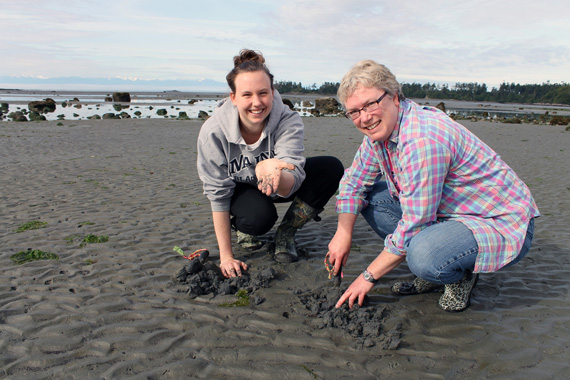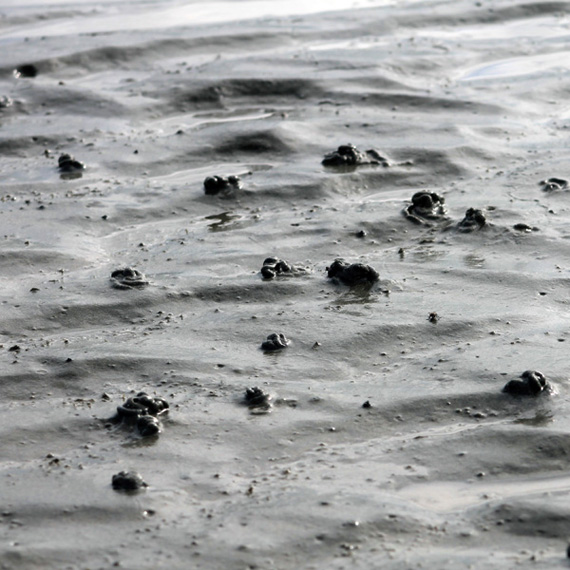Clear as Mud: Burrowing Behavior of Marine Invertebrates
(by Sara Lindsay, University of Maine School of Marine Sciences
slindsay@maine.edu)

The UW Tidelands at False Bay are a very special place. Seen from the bank at low tide, the bay presents as a wide expanse of sand and rocks, with tide pools and winding streams superimposed on sand ripples. A closer look reveals pits, holes, trails, mud pimples, piles, and tubes that reflect the activity of animals living on and in the sand and mud. I’ve been conducting research at False Bay since the late 1980s, studying the ecology and behavior of marine worms (polychaetes), in order to understand what factors affect their sediment disturbing activity.

As they feed on sediments, burrow and irrigate their tubes and burrows, the animals that live in the sediments (or infauna) alter the fluxes of nutrients and chemicals between the sediment and the overlying water. Sally Woodin has aptly called them “Hydraulic Ecosystem Engineers.” Infauna alter sediments too, and these activities can affect competition and recruitment of new individuals. So understanding what factors coordinate infaunal behaviors, especially subsurface behaviors, is important for being able to predict infaunal activity rates, and the degree to which they influence sediment-water fluxes and sediment disturbance. This has been the major focus of my research at False Bay in recent years.
In 2010 and 2011, I conducted experiments at False Bay to investigate how injury affects infauna, testing the hypothesis that repeated injury results in additively negative impacts on activity and growth. Lugworms (Arenicolid polychaetes) often lose posterior segments to predators such as juvenile flatfish. With help from my family and University of Maine undergraduate student, Katelyn Hunt, I planted injured worms in a garden of mesh “pots” and tracked the worms’ defecation activity for a month. Repeated injury reduced the proportion of worms defecating, but not the amount of sediment defecated, suggesting a compensatory response in terms of feeding. Indeed, worms injured twice had similar growth rates to those injured once or not at all. This result was surprising given results of our experiments with bamboo worms (Maldanid polychaetes), showing that repeated injury significantly reduced growth rate compared to single injury. Such species-specific differences challenge the broad generalizations that benthic ecologists (including me) have made about how injury affects infaunal activity.

At the other end of the worm, “tastiness” of the sediment is another factor that can influence sediment disturbance rate. I also study how sensory systems, particularly chemoreception, influence feeding by infauna. Responses to waterborne or surface chemical cues are fairly easy to document, but it’s a whole lot harder to see what worms do under the sediment surface, unless you have clear mud. And although False Bay is “practically perfect in every way,” its sand is definitely not clear. This spring at FHL, Katelyn and I worked to track burrowing by polychaetes and infaunal sea cucumbers using time lapse photography of the sediment surface combined with particle image velocimetry to track the movement of surface sediment particles displaced as the animals burrow. By tracking the particle motion, we can follow the animals’ subsurface tracks and calculate their speed and turning rates in various types of sediment.

I also observed how sensory organs are deployed during burrowing using stereomicroscopy and a special apparatus designed to provide a clear, flexible window over sediment. This has been loads of fun, because for the first time I can see how worms’ chemosensory organs contact sediments during burrowing, and what behaviors might enhance supply of pore-water dissolved cues to them. We’ll be continuing our experiments and observations back home in Maine this summer, but will miss the easy access to a diversity of subsurface burrowers found at False Bay.



